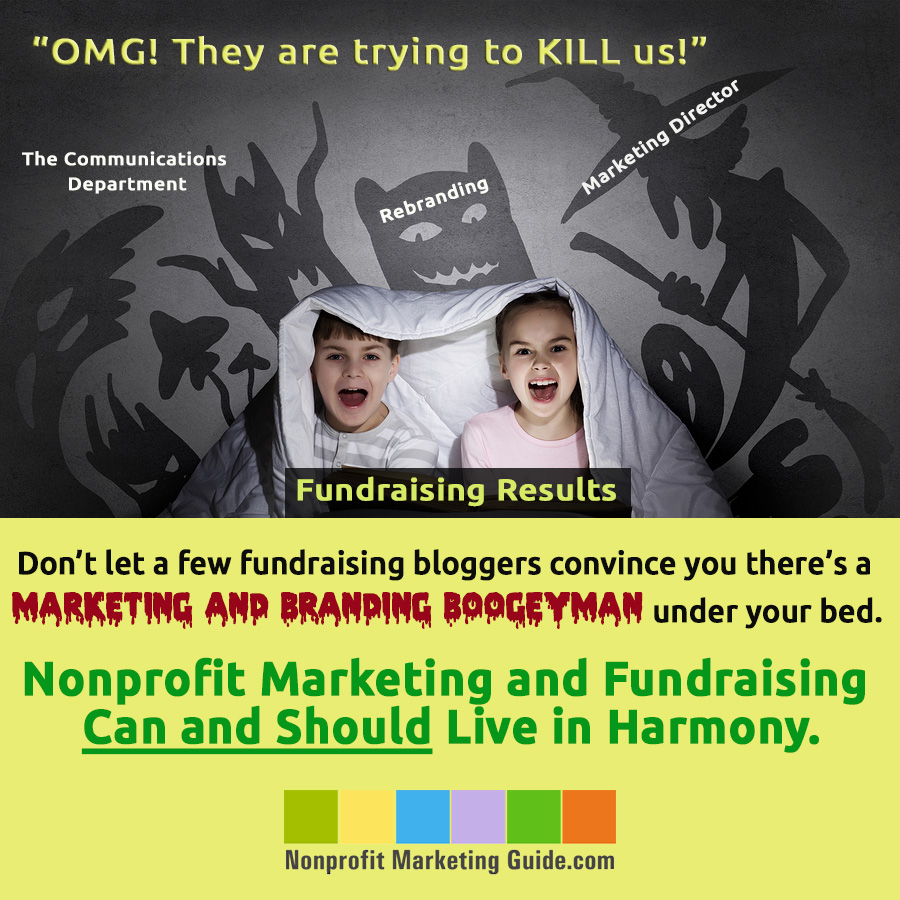
Some fundraising bloggers/consultants have discovered a terrifying new boogeyman – the work of nonprofit marketing directors! Hurry, get the pitchforks and the lighter fluid. We got us some branding hocus pocus witches to burn!
Oh, haven’t you heard the hysteria? Yep, nonprofit marketing and branding are apparently killing fundraising. Killing it, they say!
“Marketing takes your organization the WRONG WAY.”
“Marketing is not donor-centered.”
“Marketing and all your organizational communications need to SERVE fundraising.”
“Fire your branding expert, your marketing grad, your advertising creative from the commercial world. Save your organization’s money.”
You can read a bunch more of these gems here, here, here, and here.
All this time . . . it wasn’t fundraisers who were responsible for fundraising and the oh-so-pathetic donor retention rates. It was the marketers. Huh.
Yeah, OK. I’m a wee bit defensive about this one, because nonprofit marketers are my people. And I am one of their loud mouths. So if I don’t get riled about this ridiculousness, who will?
But I really want to be my typical helpful self, not just another snarky blogger.
So, let me stop with the eye-rolling and four-letter word flying about this stuff (and there’s been a fair amount of it), and try to share a few observations that might actually encourage some mature conversation about this.
The misguided people who make bad communications decisions in nonprofits are just as often the development directors or executive directors as the communications/marketing directors.
In my experience, I see just as many development directors and executive directors creating really bad communications as marketing directors. Many of these bad decisions come out of fear of trying something new, and especially with development directors, fear of offending donors. This fear was not suddenly introduced by a rebranding conversation. They’ve been terrified all along.
Who you might label the “bad communicators,” regardless of job title, would rather talk about themselves (not donor-centric) because they understand themselves. Talking about donors, well, that would mean they actually understand their donors and have been listening to them. It’s amazing how little many nonprofits can tell you about their donors beyond their giving history, and that makes good marketing and fundraising tough. (Listening to those we communicate with is a core principal of marketing, by the way, as in market research.)
I constantly talk about how to be more real, transparent, and engaging in nonprofit communications. In my experience, the marketing staff are usually the ones trying to bring that change into nonprofits, not shut it down, as some of said bloggers have claimed.
And good marketing and fundraising takes work, hard work. Too many people in power at nonprofits don’t understand that, and think anyone who can write a complete sentence and take a half-way decent photo is qualified to do communications work. Not so.
To serve the missions of their nonprofits, most communications/marketing directors have multiple goals, of which fundraising is just one.
Depending on the nonprofit, fundraising may be the most important goal for the communications director, or it may be the least important goal. Totally depends on the organization, its mission, how it is funded, etc. There is no “one size fits all” on nonprofit communications goals, and therefore no one goal is always paramount.
Our Nonprofit Communications Trends Report data is very clear about this. Communications directors and executive directors are both more likely to define their success as riding on a combination of programmatic, community engagement, and fundraising goals than development directors who have the luxury of focusing primarily on fundraising. This stuns many development directors — I have seen their eyes narrow and heads tilt as they try to imagine what the heck a communications director could be doing if they aren’t fundraising.
There’s a lot, trust me. Communications directors are often tasked with acquiring and retaining not just donors, but program participants, advocates, and volunteers. They must also build influence with elected officials, the media and other community power brokers. When the mission of the nonprofit is educating the world about a wrong and how to right it, or encouraging behavior changes in individuals, that too is usually on the communications director’s plate. We often lump all this stuff under “engaging the community” as shorthand. Changing the world is the hard work of nonprofits, and that requires more than just the money that fundraisers bring in.
I suspect all this finger pointing is really about power grabs and budget control. Few people in the nonprofit world get the budget they need. That’s part of the deal, unfortunately.
I know many of you are thinking, “Wow, I wish I had the luxury of a power grab, but I’m the only one running this place. Let me take a moment to grab myself.”
Some fundraising bloggers don’t even pretend about this one – they come right out and say that marketers should work for fundraisers – “serve them” – and that you shouldn’t spend money on marketing and branding. Not real hard to figure out whose budget they think should get that money.
In our Nonprofit Communications Trends Report, only 10% of communications directors reported to the development director. Just like development directors, most of them report to the executive director, as it probably should be. But again, it depends on the situation, mission, and goals of the organization.
How about choosing to do the hard work the right way, and getting along instead?
Be respectful and be specific. Talk about it, for crying out loud. Stop the partisan bickering. Americans hate it in politicians – can you imagine how disgusted your donors would be if they saw it in your nonprofit? If you understand that a branding style guide could help supporters see that the 10 events you run each year are all your nonprofit’s events, not 10 separate events by 10 different nonprofits, BUT also know that the same style guide conflicts with what are the best practices for direct mail formatting, then please, by all means, talk about THAT. Not how “marketing is killing fundraising.”
Acknowledge that your job title (or who is paying your consulting fee) influences your job responsibilities and goals. See where those goals overlap and where they don’t, and remember that it all feeds up to the larger mission. Work through how everyone can get their jobs done in a way that supports each other. Stop worrying about who is servicing whom and who gets fired. Sheesh.
These are the kind of conversations I’m having every day with my coaching and consulting clients. It’s amazing how much fun you can have and how much good stuff you can really make happen in the world with a little internal coordination and cooperation.
And for those of you who are both the communications director and the development director (and maybe the program director, or the advocacy director, or the executive director), see, it’s not all so bad. There’s one good thing about being understaffed: You are spared this stupid infighting.
My kids have some left-over “monster spray” from when they were little and afraid of bumps in the dark. Let me know if you need it. We aren’t afraid of the boogeyman. How about you?





